Comfrey
Though Comfrey has long been mired in anti-marketing by the ‘expert’ class, we, in our usual rebellious way, have been making Comfrey tea for various uses including our water pic juice for periodontal care. In Traditional Western Medicine, comfrey has been utilized as a powerful wound healer from ancient times. More controversial is that for thousands of years it has been used as food for humans and livestock by many groups, while being regarded as poisonous by others.
We used to make bulk quantities of comfrey tea from the fresh leaves and store some in the freezer.
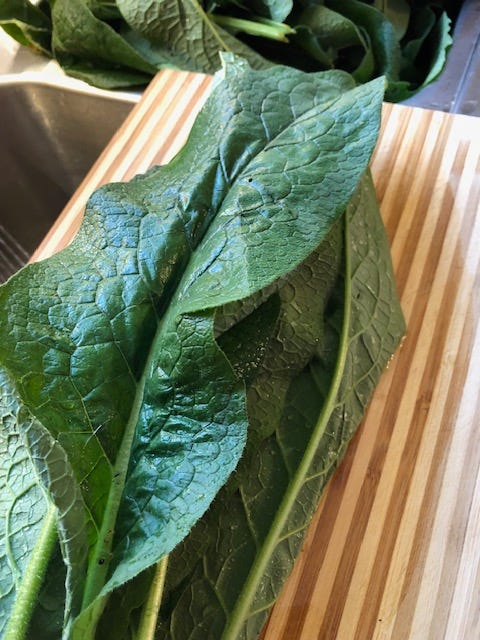
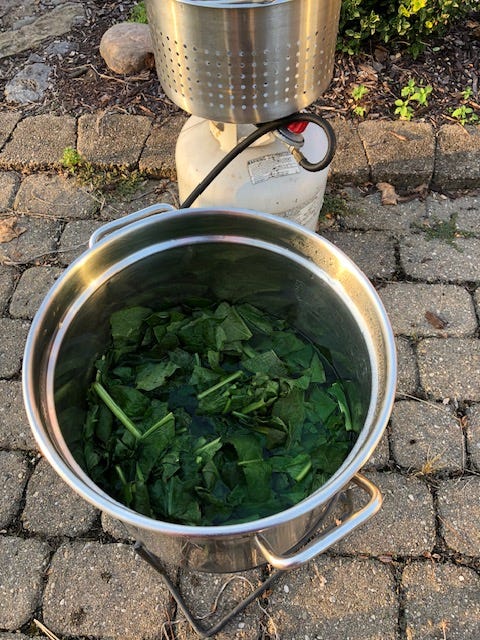
We now have a lot of space to dry the comfrey leaves as well as a freeze dryer, so it’s become a lot more convenient to store the dried herb and use it as needed for various recipes. Dried herb is definitely the best for infusing into oils. There are plenty of good reasons for comfrey to be used as a poultice or a topical, leave-on ointment. It performs comparably to topical arnica and topical diclofenac for arthritis pain in joints, sports injuries such as sprains, myalgia, and for back pain.
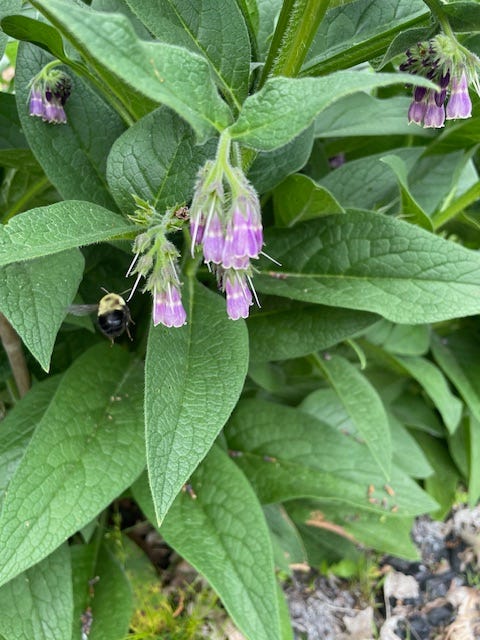
Getting into the comfrey botany, there are about 35 species in the genus Symphytum, of the family Boraginaceae. There are two main types which are domesticated and used as medicine in the region of weedom, (northernmost USDA zone 6, midwest U.S.). The one with the longest tradition of use in Western botanical medicine is Symphytum officinale. This herb hails from Europe, and its bouncy seeds have allowed it to escape the herb gardens and propagate widely. Though it seems to like shady moist areas, the extensive root system allows it to be fairly drought tolerant, dying down early and re-emerging the next Spring. Its Linnean name proclaims its position in the herbal apothecary, as the official weed to knit wounds and even bone back together. Another common and more vigorous plant has been produced by hybridizing Symphytum officinale with Symphytum asperum, prickly comfrey. The hybrid is called Russian comfrey, Symphytum x uplandicum. There are a collection of cultivars of this sterile product, which have to be propagated by root divisions. The Russian comfrey seems to be disease resistant, with a strong nutritional profile, high protein content, incredibly vigorous production of leaves, and very good for animal fodder and for composting. At no time during our 2 summers of drought did the Russian comfrey completely die down, and since we finally got some rain this week, it’s blasting out a final flush of leaves.
Once you plant comfrey in a field, it’ll stay there, with its roots stretching halfway to China, pulling up minerals from the depths. If you dig it out, you’ll leave root pieces that will eventually sprout. If you plow it under, the root system will break up and sprout a bunch of new plants. A number of our comfrey plants resulted from digging under our very first plant when the pipe leading out from our potties broke underground. We rescued a piece of the plant from above. Some of the dirt (plus other brown goodies) dug during the pipe repair had to be placed elsewhere. The following spring we were gifted with numerous volunteer comfrey plants, quite happy in their humanure mixture, which had aged to perfection.
The 2 foot high prickly comfrey, S. asperum, native to the Caucasus region, Iran and Turkey, grows to about 2 feet high, and has larger 1/2 inch, often bluish flowers. Leaves and stems have prominent recurved prickles. The leaf stems (petioles) have wings which do not clasp the flowering stem, which itself has no wings at all.
Symphytum officinale reaches a height of 1 to 3 feet (0.3 - 0.9 meters). Racemes of drooping, tubular 1 inch, (2.5 cm) bell-like flowers appear in late spring to early summer. The pointed tips of the calyx at the base of each flower notably curve backward in comparison to the other 2 species. The leaves on the flowering stalk clasp the stem with their basal wings extending down the stalk. This is another distinctive feature of the official comfrey. Both large ovate leaves and stem are rough and quite hairy, but less prickly than S. asperum.

Russian comfrey, Symphytum x uplandicum (Bocking 14 cultivar) is the main variety which has propagated at weedom. It’s very similar to the official comfrey, but bigger, bolder with even more hair on the leaves, and stems. It reaches over a meter in height, and produces a massive basal rosette of leaves before blooms emerge in May. The flowering stem lacks the large wings extending from the leaves of official comfrey. The tips of the flower calyces do not curve backwards away from the flower as in the case of official comfrey.
At early stages, the foxglove plant (a definite do-not-eat) could possibly be confused for comfrey, but the leaves of comfrey are very rough, more oval, while the leaves of foxglove are velvety with very fine hairs.
The happy chemistry.
Official comfrey and Russian comfrey are both great sources of the magic molecule allantoin, which stimulates wound healing. This molecule is a ubiquitous metabolite in plants and many animals coming from the metabolic processing of purines. It’s found in larger amounts in comfrey roots, and in lesser amounts in the leaves. Allantoin has been observed to cause increases in vasodilation, presence of inflammatory cells, new blood vessel formation, fibroblast proliferation, and deposition of collagen, all of which are associated with the process of wound healing. Innumerable pharmaceuticals and cosmetics are available which contain synthetic allantoin. Comfrey roots contain 2-3 times as much allantoin, and about 1.5 times as much rosemarinic acid as the leaves, however the leaves offer hydrocaffeic acid chlorogenic acid, rutin, p-aminobenzoic acid and higher tannin content. Rosemarinic acid is a potent anti-oxidant, used extensively as a preservative. It posesses anti-inflammatory, antiviral, anti-allergic, anti-bacterial, neuroprotective and anxiolytic properties. We know why people dig up the roots of comfrey. They can be stored longer, and they have higher concentrations of useful wound healing components. However the leaves offer significant topical benefits due to their flavonoid and tannin contents.
The “unhappy” chemistry.
Having access to such a powerful healing plant, is just too much personal autonomy, so maybe that’s why the U.S. FDA generally banned dietary supplements containing comfrey somewhere around 2001. This was based on fear of pyrrolizidine alkaloids (PAs) which might kill us if we consume ginormous amounts of comfrey, most particularly the root, which seems to have 10 or more times the amount of these compounds than the leaves. This vast array of molecules, varying widely in amount and in intrinsic toxicity are found in numerous plant families and genera, with the most toxic ones in the Senecio, Crotalaria and Heliotropium genera. The most toxic known compound of this class (the retronecine macrocyclic diester, riddelliine) is utilized as the basis for the recommended exposure limits on all PAs. Meanwhile most of the PAs in Symphytum officinale are of the least toxic chemical class, (retronecine monoesters) and the rest are of another low toxicity class, (retronecine diesters) and their total concentrations are also fairly low among the plants containing pyrrolizadine alkaloids. This explains why foragers continue to eat the comfrey leaves, both raw and cooked, and Susun Weed’s troop of ‘wise women’ drink “nourishing herbal infusions” using 1 ounce of dried herb per quart of water. Comfrey is 1 of their basic 4 herb lineup, and 78 year old Susun says she’s has been at it, alternating those herbs, and drinking about 5 quarts weekly for over 3 decades. She’s still strongly pushing this practice on her 2024 podcasts.
Meanwhile, figure out if you’d actually like a few pyrrolizidine alkaloids, because various members of this class, (including the fairly toxic echimidine occurring mostly in S. asperum and somewhat in weedom’s hybrid S. x uplandicum, but not in S. officinale) have been found to have antifungal and antibacterial activity, antiinflammatory and antiviral activity, etc. It’s interesting that antifungal pharmaceuticals on the market have toxic effects upon the liver and/or kidneys, or are not recommended during pregnancy. If you overdose and overcome the detoxifying glutathione supply from your liver, these PAs particularly those macrocyclic diesters from the more poisonous plant species, can form adducts with proteins and screw up vascular endothelium, thereby occluding the blood vessels of your liver and leading to all sorts of severe unpleasantness. Or they can potentially bind to DNA and perhaps lead to tumor formation. More is not always better. Interestingly the rosemarinic acid found in comfrey is hepatoprotective, increasing the glutathione production, and potentially serves as an antidote.
The more experienced herbalists, leaning on tradition and past results, tend to use Comfrey roots topically, and the leaves internally. Many will recommend to use avoid internal use of comfrey leaves by pregnant or nursing women, and babies and those with preexisting liver disease. The topical sprays, soaks, poultices and ointments will not deliver significant amounts of PAs into the system. The n-oxide PAs are very water soluble, and the esterified PAs dissolve into acidic aqueous solutions, but are much less soluble in alkaline solutions. (So comfrey vinegar is not the best.) PAs also are relatively insoluble in fixed oils, so ointments are a safer, topical, leave-on product. It seems that supercrtical CO2 extraction methods are also able to produce comfrey products with greatly diminished PA content. Some of these PA free products are sold commercially. The PAs are most efficiently extracted with acetone and mid strength ethanol solution. So those with PA concerns should probably lean towards teas rather than tinctures. Herbalists rely on comfrey internally as the primary herb in formulas to heal digestive ulcers. Externally it’s applied to skin injuries, as well sprains, bruises, broken bones and arthritic joints.
Why would people want to eat comfrey leaves? It has mega Vitamin A, up to 28,000 units per 100 grams dry. It also is a unique plant source of vitamin B 12. Getting enough of that nutrient is problematic for vegans. The leaves contain a whole array of B vitamins, C and E and a very high proportion of protein. A cornucopia of minerals are dragged up into this plant through the 10 foot roots.
Permaculturalists regard comfrey as a “biodynamic accumulator” because of its deep roots. The leaves are used directly as compost to fertilize other plants which lack deep root systems, and to renew the topsoil. Every garden should have some. Water with comfrey tea to stimulate tired houseplants.
By all means, grow your own comfrey! For lowest, least toxic PAs allowing the greatiest versatility of use topically or internally, we recommend planting Symphytum officinale, although we are pretty satisfied with the hardiness and usefulness of our Symphytum x uplandicum. Just be aware that once you set that comfrey into the ground, it’s a more permanent resident than any tree :-D
Where We Dig
1. True Comfrey - Symphytum officinale | North Carolina Extension Gardener Plant Toolbox. Accessed October 2, 2024. https://plants.ces.ncsu.edu/plants/symphytum-officinale/common-name/true-comfrey/
2. Thayer S. The Forager’s Harvest - A Guide to Identifying, Harvesting, and Preparing Edible Wild Plants. Forager’s Harvest Press; 2006. https://openlibrary.org/books/OL8588402M/The_Forager's_Harvest
3. The efficacy and safety of comfrey | Public Health Nutrition | Cambridge Core. Accessed October 2, 2024. https://www.cambridge.org/core/journals/public-health-nutrition/article/efficacy-and-safety-of-comfrey/50C49FEFA056383BD2298CA9184CEE74
4. Stickel F, Seitz HK. The efficacy and safety of comfrey. Public Health Nutr. 2000;3(4a):501-508. doi:10.1017/S1368980000000586
5. Salehi B, Sharopov F, Boyunegmez Tumer T, et al. Symphytum Species: A Comprehensive Review on Chemical Composition, Food Applications and Phytopharmacology. Molecules. 2019;24(12):2272. doi:10.3390/molecules24122272
6. (PDF) LC-MS/MS Evaluation of Pyrrolizidine Alkaloids Profile in Relation to Safety of Comfrey Roots and Leaves from Polish Sources. Accessed October 2, 2024. https://www.researchgate.net/publication/373255904_LC-MSMS_Evaluation_of_Pyrrolizidine_Alkaloids_Profile_in_Relation_to_Safety_of_Comfrey_Roots_and_Leaves_from_Polish_Sources
7. Nourishing Herbal Infusions. Accessed October 3, 2024. http://nourishingherbalinfusions.com/
8. Kimel K, Godlewska S, Gleńsk M, et al. LC-MS/MS Evaluation of Pyrrolizidine Alkaloids Profile in Relation to Safety of Comfrey Roots and Leaves from Polish Sources. Molecules. 2023;28:6171. doi:10.3390/molecules28166171
9. Staff. Identifying Comfreys - Mother Earth Living. Accessed October 2, 2024. https://www.motherearthliving.com/gardening/plant-profile/identifying-comfreys/
10. Ganora L. Herbal Constituents, 2nd Edition - Foundations of Phytochemistry. Lulu Press, Inc.; 2021. https://openlibrary.org/books/OL35083771M/Herbal_Constituents_2nd_Edition
11. David Hoffmann ~ Is Comfrey Safe? Accessed October 2, 2024. https://herbcraft.org/hoffmanncomfrey.html
12. Dresler S, Szymczak G, Wójcik M. Comparison of some secondary metabolite content in the seventeen species of the Boraginaceae family. Pharm Biol. 2017;55(1):691-695. doi:10.1080/13880209.2016.1265986
13. Awang DVC. COMFREY UPDATE. COMFREY UPDATE. American Botanical Council. Accessed October 2, 2024. https://www.herbalgram.org/resources/herbalgram/issues/25/table-of-contents/article839/
14. Comfrey – Herbs are Special. Accessed October 2, 2024. https://herbsarespecial.com.au/plant-information/herb-information/comfrey/
15. Blog - Queen Comfrey (Symphytum officinalis) – Shaking Off the Fear that Binds Us. Sage Consulting & Apothecary. August 22, 2024. Accessed October 3, 2024. https://www.sagewomanherbs.com/blogs/herbal-education/queen-comfrey-symphytum-officinalis-shaking-off-th/?source=facebook




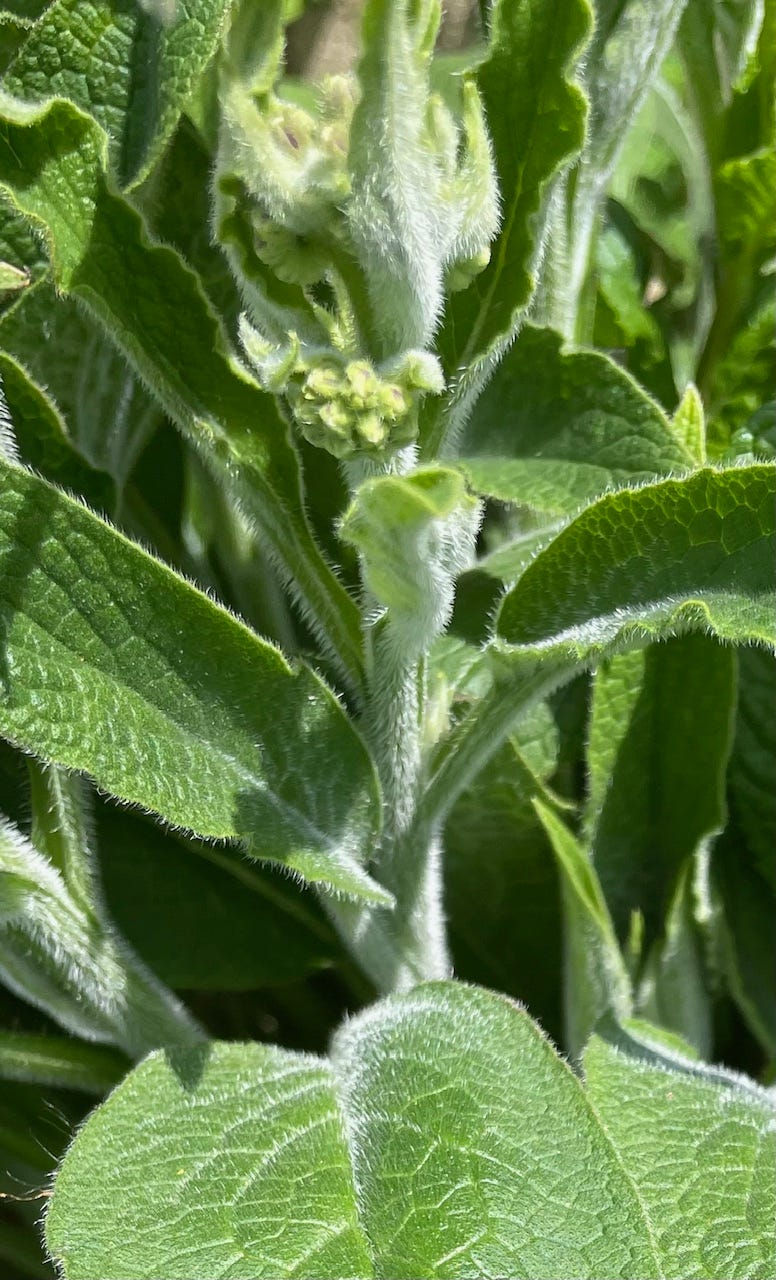
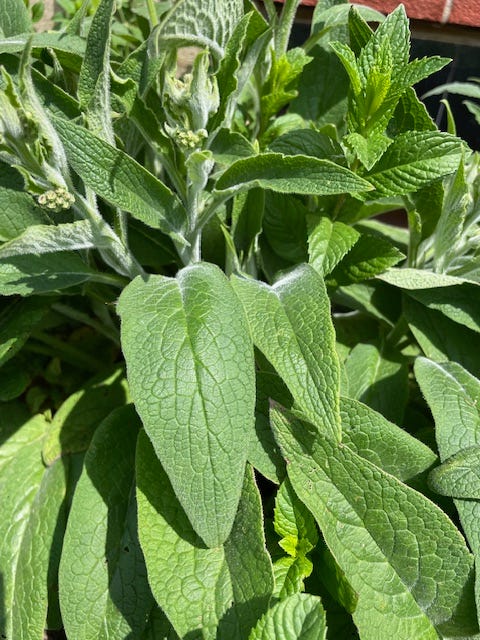
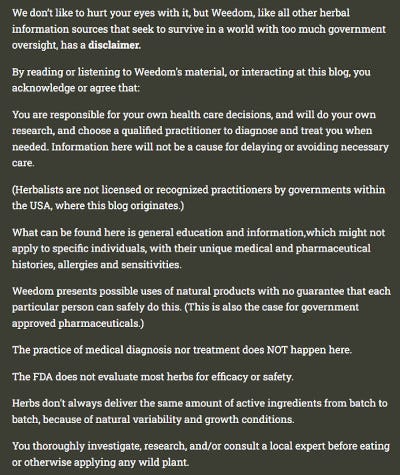
I recently did something stupid and "normal" and hurt my shoulder trying to untangle the bags I was carrying full of things. I couldn't raise my arm above my head without pain... a definite strain. Made a comfrey tea... let it cool, soaked a towel and wrapped my shoulder for about 10-15min. Next day, no pain, had full range of motion! Have done this with sprained ankle also... made a comfrey salve for topical!! LOVE comfrey!!!
Hi weedom1, I don't know if you remember me so I will remind you of our correspondence.
When you did the piece about 'the real yucca', I had ordered some from a vendor from amazon. I waited for almost 2 weeks & it never came then got my money back. Waited about another week and ordered from a different vendor. Again, a week later had not even shipped. Got money back there too. Anyway, never got my 'real yucca' seeds. I guess I will try again...in the spring from who knows where. Do you have any ideas except amazon?